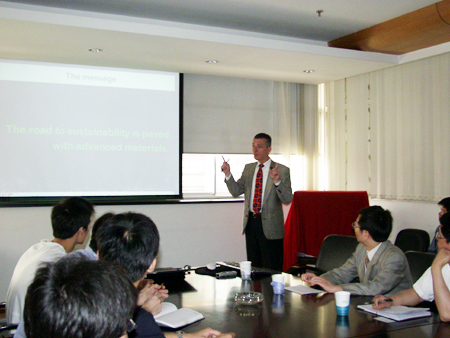Prof. Donald R. Sadoway from Massachusetts Institute of Technology Visited SICCAS

On May 21, 2007, invited by Prof. Lidong Chen, deputy director of the institute, Prof. Donald R. Sadoway from Massachusetts Institute of Technology (MIT) visited Shanghai Institute of Ceramics, Chinese Academy of Sciences. He presented a lecture on “Electrochemical Pathways Towards Sustainability”.
Honored as a John F. Elliott Professor of Materials Chemistry in the Department of Materials Science and Engineering at the Massachusetts Institute of Technology, Prof. Donald R. Sadoway has published 125 scientific papers and holds 14 U. S. patents. In his speech, Prof. Sadoway firstly introduced metal production by electrolysis of molten oxides of transition metals exhibiting electronic conduction which can avoid unfavorable by-products such as CO2, polycyclic organics, benzene, CS2, Cl2 and sundry HAPs including Mn & Pb, etc. Some relevant engineering sciences, e.g. electrical conductivity measurements, transference number measurements, process kinetics and electrolysis testing were also discussed in his presentation. Then Prof. Sadoway introduced the study of the solid-state polymer thin-film lithium batteries using fully dense oxide as cathode, solid polymer as electrolyte and metallic lithium as anode. The specific energy of the battery is as high as 400 Wh/kg, which can nearly make GM’s concept electric vehicle eliminate trips to the gas station. Furthermore, there is no greenhouse gas emission. Various novel battery designs were introduced in his lecture.
The excellent lecture of Prof. Sadoway received great appreciation and aroused great interests of many scientific researchers and graduate students. After the lecture, the two sides had an in-depth discussion.
During his stay in SICCAS, Prof. Sadoway also visited the laboratory of the Energy Materials Research Center of the institute and discussed with Prof. Zhaoyin Wen, the director of the research center, and Prof. Fuqiang Huang on possible bilateral cooperation on energy materials and their applications.
Energy Materials Research Center



